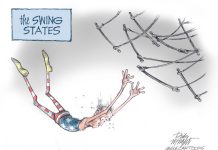Sometimes I wonder if these times are filled with more conflict, or is it the normal state of things. We seem to have our fair share at the local level, and also at the state, national and international level.
This is not going to be another column about some particular element of conflict we face at all those levels, but a look at conflict itself. You can fill in the content of whatever your current favorite conflict is.
Typically, conflict is seen as a battle of two forces battling it out to dominate each other. Whether that is a war (the ultimate example of two forces), political parties fighting each other, local agenda items in city and county council meetings or even the little battles each of us play out in our personal life, conflict operates in similar fashion.
It is one side declaring a position, and the other side pushing back in resistance. If the sides are of equal strength, there is a stalemate. If one side dominates, then they get their way and victory is declared. The other side licks its wounds and waits until the next time.
In this process, there is an enormous amount of energy expended by both sides that leads to nothing until a victory is declared. And when it is stalemated long enough, the solutions are compromises.
A compromise is when one side gives a little and so does the other, so the fighting can stop. It is a solution that leaves neither side completely happy, but at least the battle is over. We move on to fight another day. I hope this sounds familiar when you think of the latest conflict in your mind.
There is another option that I used to teach in businesses confronted with this huge waste of energy spent on endless conflicts. That is, conflicts do not produce products or services that satisfy any customers; they just are a costly and time-consuming waste. I called this a “third force model” of conflict.
In this way of thinking, we begin with the typical two forces in a stalemate (no one chooses this model when they have all the power and dominate all conflict). The third force is a process of discovering an option that gathers the energy of both sides, and redesigns an approach to the issue that brings them together, rather than setting them against each other.
It begins by having each side put their position aside temporarily. If either side cannot do this, then this will not work. But, when I have seen both sides set their position aside for a bit (not give it up) and try this, it is often very successful. We would find common ground that both sides can agree to that goes beyond the basis of the conflict. With that in mind, we work on finding a new approach to the issue at hand.
This new approach is the “third force.” It is a reconciling force that combines the energies of both sides and creates a totally new relationship in regards to the problem. It is energizing and a positive solution.
Years ago, we did this with Cummins’ suppliers and created partnerships instead of adversaries. I did this with unions where we created joint labor/management approaches to shop floor issues. And I have seen many disappointments when neither side would relinquish their positions, and instead chose to stop all progress in the name of being right.
Find the conflict that you are dealing with and see if you can step back and get your opposition to do the same, and look for your common ground, and see if there is a new and unique solution that can be developed.
Columbus retiree Tom Lane served as a consultant to a number of companies in his career. In recent years his has been a familiar name to readers of The Republic’s letters to the editor. He can be reached at [email protected].




